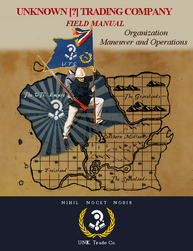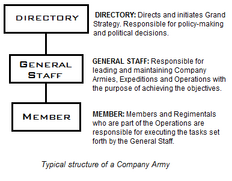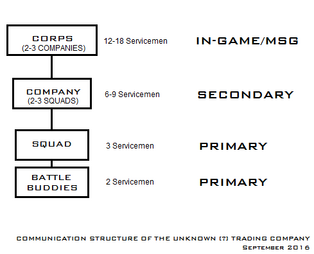Squadfighting or Company Warfare is the UTC's successor PvP doctrine to Formation Fighting. Though essentially an update of Formation Fighting with many of its precepts and lessons kept, Squadfighting contained new emphasis on subordinate officers and organizational concepts. Unlike in Formation Fighting, where the Company essentially fought as one huge force under a highly rigid and centralized command, Squadfighting subdivided the group. Greater trust needed to be placed in junior officers commanding sub-units by higher-ranking officers—a belief that they could adequately achieve their objectives without micromanagement from higher ranking commanders.
These small units were allowed greater decision flexibility to deal with changing situations on the ground, rather than have decisions made for them by commanders who at times, did not get the full picture.
More than a PvP method, Squadfighting, or more appropriately called as Company Warfare utilized a subordinate officers' initiative not only on a tactical level, but on a operational and strategic level as well, with the introduction of a military staff, it gave an administrative and logistical nerve center of a functioning Company Army. Due to a Staff, the UNKNOWN [?] Trading Company is able to effectively maintain a long-term operation by dividing the mental workload of planning, intelligence gathering, recruiting and operating.
History[]

The Field Manual 2016, compiling all the lessons learned from the modernization program after the Al Hasa Disaster.
Before the adoption of Squadfighting, the UTC developed Formation Fighting after the June Reforms and the Company used it as its main fighting doctrine for over three years, as it was so effective in the South. When the Company began its military adventures in the Midlands, the doctrine was unofficially abandoned by the boots on the ground, where even high command's strategy emphasized force concentration and massing of skill and gear against opponents. After the Al Hasa Disaster, where an entire company(6) of UTC raiders were killed without loss or harm to the enemy, the Company realized that its fighting style was increasingly obsolete and Irishkaiser commissioned an inquiry and re-evaluation of the Company's doctrines and fighting methods.
Realizing that the UNKNOWN [?] Trading Company lacked experience and capacity in fighting full-scale Northern wars, the commissioners reformed the military structure of the UTC. The idea of dividing people into teams is as old as 2012, when the QuART unit was active but the idea of of "buddying" was largely forgotten until Paluster 2016, where the Battle-Buddies(and later Squads) made their official return. Through trial and error and several Wars in the Midlands, the Company eventually put everything they learned to the test in the Spookyfest Campaign, with much success.
The ad hoc solutions found to fix the flaws of the developing doctrine during the Spookyfest Campaign were finalized and became the UTC's official methods of waging war, constantly honed through frequent practice of war games.
General Staff[]

The General Staff simplifies the command structure to allow faster response to the changing military-political landscape.
A General Staff is a group of officers, enlisted and or civilian personnel that are responsible for the administrative, operational and logistical needs of its unit. It provides bi-directional flow of information between a commanding officer and subordinate military units. A staff also provides an executive function where it filters information needed by the commander or shunts unnecessary information.
Staffs, in their primitive form, sporadically appeared as far back as the Southern War and the even up to the Defense of Frostbain, where individuals were empowered to make decisions and sometimes, people who were above the Staff in their regular Company Membership rank, would subordinate themselves to the Staff's orders and commands, such as Directory Member Irishkaiser who fought in the Defense of Frostbain campaign as a common soldier in the ranks.
Buddies, Squads, Companies & Corps[]

A diagram showing Squadfighting's subdivision of units and their lines of communication.
The trademark feature of Squadfighting is its subdivision of players into Battles Buddies, Squads, Companies & Corps, which gives UTC military units both a structure and flexibility in the field. According to the Field Manual 2016, the subdivisions are:
- The battle buddies - a two-man independent team, most suited for short term tactical operations.
- The squad - the smallest tactical group that is the capable of performing independent tactical operations, rarely acts alone, but as part of a company. Led by a squad leader with the rank equivalent of a field corporal.
- The company - the medium-sized tactical group; most capable of performing independent strategic operations, composed of two or three squads, under the overall supervision of a company commander with the rank of a field captain.
- The corps - the largest tactical group; it is most capable of tackling an entire campaign, a theater or large scale operation, composed of two or three companies, under the overall supervision of a corps commander, with the rank of a field marshal/general.
Heavy Infantry Tactics[]
As in Formation Fighting and other doctrines(or lack thereof) the Iron Armored infantry still form the core of battles and the basis of PvP tactics. Like its predecessor, Squadfighting still emphasized the "flexible use of maneuver" and the Napoleonic spirit of waging war, which is the economic application of force to achieve victory at a decisive location to affect the outcome of the entire battle.
The major emphasis in heavy infantry tactics involves a degree of decentralization of command, giving the army the ability to rapidly react in what the engaged officer deems as appropriate for the current situation. In order to do this, each Company or Squad are given unit heads, which are either a Field Captain or a Field Corporal respectively. The two are responsible for the component unit they are given and can act independently from the top echelons, as long as they operate within the given parameters of their orders.
Heavy Infantry in the Battlefield[]
The Heavy infantry's role changed very little from Formation Fighting, though there are some accurate corrections in semantics(mainly the line is now called column and oblique is more accurately called a line), the Heavy Infantry is still used as the main fighting force of any battle and as such are still massed together to concentrate combat power at the decisive point.
In order to move a large group, the column formation is used due to its narrow and long form, which suited soldiers marching down a road or moving quickly together towards the enemy across an open field. Though the column formation could not fully employ all of its members to fight, the regiments quickly change formation as enemies drew closer. The battle formations for contact with the enemy include the Wedge, the Line and the Square.
The once "experimental" wedge is now the squad's "default" formation as it provides for both firepower and maneuver. However, it becomes more unwieldy as the numbers go above three.
The line formation is usually made up of one long horizontal line but if numbers permit: two ranks - which helped present as many soldiers as possible allowing the unit to control a wider portion of the battlefield than the Column and maximizing the firepower of the unit.
The square formation, though it is less frequently used in Northern fights as maneuver fights are more common, is still a viable strategy when expecting to receive an attack from an enemy or covering an important player or objective as it's 360" field of vision allow the units to see where enemies are coming from.
Light Infantry Tactics[]
Light Infantry still perform the duties of reconaissance, screening and skirmishing against enemies with disposable equipment, but they also have been upgraded and given new form, thus expanding their capabilities further, with more northern variants functioning as disposable tanks.
Light Infantry in the Battlefield[]
Just like in Formation Fighting, scouts had many responsibilities on the battlefield. As they were generally expendable, they were free to move around and if they die, may respawn near the coastline of their death. They would perform "screening" duties which consisted of identifying the size, strength, and location of enemy forces while trying to prevent the enemy from doing the same and flank and knock enemy forces out from dangerous positions as they find them. The Light Infantry could do what the Heavy Infantry could not, whether the reasons be pragmatic or political.
For Northern Light Infantry, their use is more careful, but they have been delegated to baiting, flanking, scouting or other missions or duties that involve a higher risk of death. As such, their equipment is built so as not to give the enemy a bigger advantage when they die.
The Light Infantry generally fought in open order and encouraged to charge at the incoming enemy to blunt their attacks, sending the initiative back to the defenders. If the Scouts die, their player zombies would do the fighting for them and thus, even a bad PvPing scout's death could boost their PvP effectiveness by having their player zombie do the fighting. The Scouts are most prominent in vanguard and rearguard actions, where they probe an area for enemy ambush and delay incoming enemy attacks and harassing enemy forces, disrupting the attackers or potential attackers.